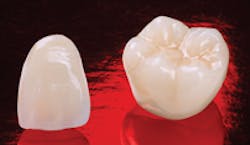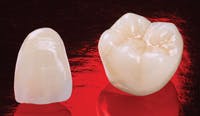Be in the know on endo
by Brad Guyton, DDS, MBA, MPH, Kathleen O'Donnell, and Diwakar Kinra, DDS, MS
Are you considering expanding your mix of services and incorporating endodontics into the practice? If so, you're probably asking yourselves key questions like "How do I schedule it? How do I let my patients know that I now offer this service? How much will this set me back? What are common pitfalls I need to plan for and avoid? What training is needed and best?"
Endodontics can be both profitable and rewarding as long as you understand it and recognize your limits. Start by taking a few hands-on courses from either Tulsa Dental Specialists (Dentsply) or Sybron and practice with their systems. The courses are typically very affordable, regionally based, taught by industry leaders, and well worth the investment. Many Jameson clients have set aside $3,000 to $5,000 and found that this is sufficient, if spent properly. Vet your CE courses before you take them. Not being proficient leads to delays with your other scheduled patients and, ultimately, lousy customer service.
Schedule the procedure initially in 90-minute blocks with the goal after six months to allot only 60 minutes. Use dovetail scheduling with the appropriate doctor and assistant time. Endo patients can be highly anxious, so keep their appointments calm with doctor and assistant time blocked appropriately so they are focused solely on the patient. Set your fee at a minimum of one-sixth of your daily production goal.
Learn your limits and which canals to refer, as they are never worth the stress. A great referral network is a must. Not knowing when to refer is what gets most dentists in trouble. It feeds right into those patients' fears about root canals and creates another war story the patient might share with other patients. This only erodes trust and confidence in your abilities and wastes everyone's time.
One of the greatest advantages of being a general practitioner is that you are the gatekeeper of your patients. You decide what stays in the office and what procedures are referred to your specialists. Proper case selection allows the dentist to choose the cases that are easy, profitable, and allow you to be successful in your patients' eyes. A convenient, pain-free, single-visit root canal gives the patient confidence in your abilities to treat them and others. This customer-centered approach allows for future internal and external referrals from that patient.
Once you create an environment that is customer-centric, you need to reinforce that environment with the appropriate verbal skills. Scripting can be one of the most challenging skills for a team to develop. When perfected, these skills empower each team member to relate to patient fears and address financial concerns with confidence. Don't get sucked into sympathizing with the patient's concerns – you'll only add fuel to the fire. Instead, respond with active listening to clarify the patient's hot buttons and then offer a solution. For example, you can say, "Sounds like you're worried this endodontic procedure may cause you pain and you're worried how to pay for it." The patient responds with their own war story of some friend or relative who had a horrendous experience with a root canal and had to get a graveyard shift job to pay for it! You respond with "I understand how you feel. Some of our other patients have had similar worries. What they found was…" And don't forget to offer flexible financing choices to fit this needed procedure into the patient's family budget, including third-party dental financing options, such as CareCredit. The verbal skills are also important to help the patient understand what type of technology has been brought into the practice and how it might benefit them.
The technology in endo is predictable and easy to use. If you have not invested in rotary instrumentation, you are now behind the curve. Single-use files are becoming the standard of care in the United States and it has been mandated for NHS dentists in the United Kingdom for over eight years. While the single-use WaveOne system may not be the solution for every tooth, it can be for most. For those dentists who still want multiple files, ProTaper NEXT is a viable option. Another product that is a game changer is the GuttaCore obturation system. Our clients that use GuttaCore are always surprised with the ease of use and, when needed, re-treatability. Many endodontists are now using the product, which really speaks to the success of the product. Another new product that merits consideration is QMix. While sodium chloride might be a great disinfectant, QMix (active ingredients are chlorhexidine, EDTA, and a surfactant) is effective in removing the smear layer and killing 99.99% of the bacteria. Hopefully the sodium chloride takes care of that other .01% that keeps you up at night!
Switching to motorized shaping and carrier-based obturation increases speed and efficiency, which outweighs any addition material cost. The end result is satisfied patients, increased referrals, and greater production. When deciding a file system to streamline the shaping process, the WaveOne system allows for a simplified technique. This system permits deep apical shapes that can accommodate irrigating syringes in the apical third of the canal system. This is the most critical zone of disinfection. Once irrigated, three-dimensional obturation can be quickly and effectively completed with the GuttaCore System. This allows the dentist to deliver heated gutta-percha throughout the canal system, which can result in impressive outcomes (see Figure 1).
The best news is you can get started with all three of these technologies for about $4,000. The return on investment for this technology is typically met in only a handful of root canals. To further enhance ROI, deliver a clear, repeated message to your patients that you have invested in a new technology and show them how this benefits them directly. We know from our clients that your patients need to be given a message five to seven times before they typically make a decision to move forward. Strong marketing and verbal skills to get your patients interested is only half the battle. We need to also build advocacy inside our walls with the team.
All too often, we see team members who, at the mention of root canals, scrunch up their faces and agree with the patient that root canals hurt and are too expensive. The irony is, once the procedure is properly integrated into the practice, many assistants find it to be one of their favorite procedures. Proactively communicating your vision of adding endodontic services into your practice is imperative. We always want the team to be part of the solution.
In Summary
We suggest that you focus on the following three goals:
- Set specific goals for the next 12 months and time activate each goal. Set a budget aside for training and equipment purchases. Your return should be realized less than one to two months after you begin implementing endo into your practice.
- Start with proper training and consider taking your assistant to the course with you.
- Develop a marketing and communication plan around this new service offering. Spend time with your team practicing the verbal skills to reinforce this new service offering for your patients.
Good luck!
About the Experts:
Diwakar Kinra, DDS, MS, maintains an endodontic private practice in Flint, Michigan, lectures on endodontics, serves as the EndoFiles editor for DE, and can be reached at [email protected]. Brad Guyton, DDS, MBA, MPH, practices dentistry in Denver and serves as COO of Jameson Management, alongside Kathleen O'Donnell, executive VP of coaching. Jameson's team of clinical, management, and marketing advisors improve the lives of dental professionals through niche in-office and virtual coaching and marketing services. When you are ready to make your dream practice a reality, they can be reached at 877-369-5558 or [email protected].
Past DE Issues

